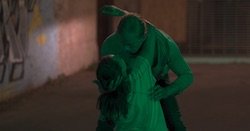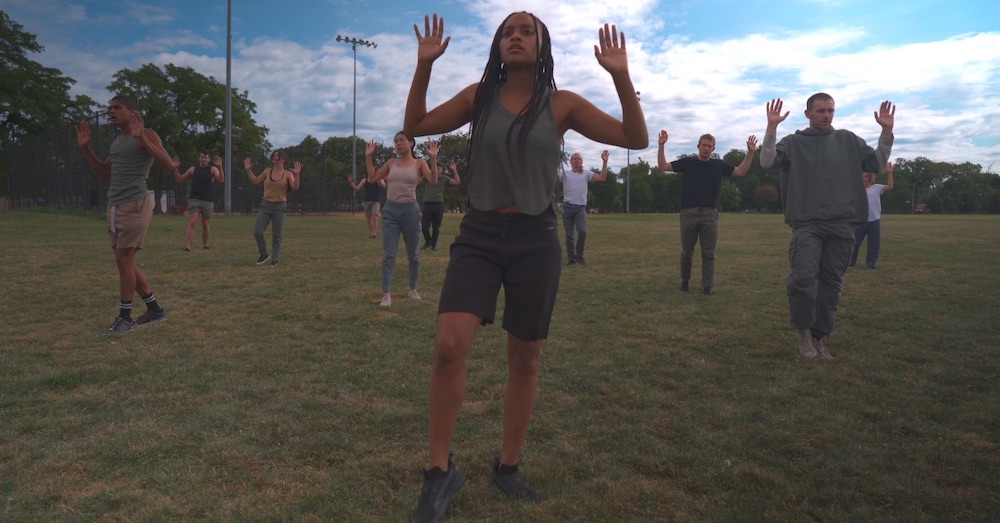Released October 2020.
Accessible through hubbardstreetdance.com.
It’s commonly said — “art is a mirror”, reflecting ourselves and our world back at us so that we can see it more clearly. Artistic works like A Tale of Two, by Rena Butler and danced by Hubbard Street Dance Chicago, can provide a clear and impactful reflection through metaphor and aesthetic abstraction, rather than a crystal-clear view. Why? How so?
As long as the metaphor and abstraction draws upon commonly understood and meaningful references, under a unified concept, it can make more of a memorable impact than a crystal-clear view ever could. With compelling metaphor and striking aesthetic abstraction, this work draws on references to creative pieces in most children’s lives — games, songs, stories — to contrast the experience of children in safe, secure environments and children who lack that safety and security in their lives.
The work opens on a close-up of children’s feet in a playground and children’s joyful laughter. That shifts to a woman strumming her guitar and singing, dancers surrounding her in a circle and gently swaying. The lyrics pull me in and fill my mind. “This life of hatred becomes a state of mind” — yes, that is what neuroscience, psychology and lived experience tell us is the case. “We’re not saying you don’t matter, you do, we’re just saying we matter too,” — which seems to speak for itself, with so much truth in few words. She stops singing and playing, and they all fall — as if her music is what kept them standing and swaying.

The mood and energy quite abruptly shifts; “PANDEMONIUM” flashes across the screen. The music changes to something full of anxiousness and tension, and dancers move with unceasing unrest. Pandemonium for sure! At times, there’s a sense of competition — of “one-upping” each other — and at other times absorption in personal experience rather than connection with those around them.
Following sections reference childhood rhymes and games. “Ba-ba black sheep, have you any wool?” is scrawled across the screen, for example. A dancer convulses and slowly falls to the ground — clearly in duress. Other dancers, who one could assume could have helped him, seem arrested in space. Later they themselves convulse and fall. What do we lose — moreover, how are we hurt, by not helping others in dire need? What are we called to for others, and what are we called to for ourselves?
Another section has “Humpty Dumpty” accompanying the dancers. A dancer moves alone, the cinematography emphasizing height of surrounding structures but also his solitude. “Three Blind Mice” emphasizes sight through small spaces and from small enclosures — bringing to mind perspective, what we see and where we see it from. A section with “Red Rover” as the accompaniment has dancers apart in a field, distance between them and an emotional distance also permeating through the air.
Part of me does want me to see some of these sections last longer (“Ring around the Rosie” flashing by in a few frames, for example), to have the time for an emotional life to truly build within them. On the other hand, quickly-shifting sections bring an exciting dynamism to the work. Adding to that dynamism, movement is released, grounded, and post-modern throughout — and excellently performed by the dancers. That movement quality, and the excellent execution of it, demonstrates that the current Hubbard Street Dance Chicago is so much more than a jazz dance company.
Strikingly, the “Don’t shoot” and “Revolution” sections at first bring to mind themes that, to me, commonly take up adults’ rather than children’s mental space. Yet thinking deeper, it hits me — deeply — how children in certain communities face violence and fights for their own safety every single day. The hatred that grows from that — well, it can become a state of mind. The gritty aesthetic in the film — graffiti on the walls and dark back alleys — reinforces this truth. Yet the graffiti has its own beauty and those back alleys their own allure.
Nowhere in the film do Butler or her collaborators condemn or prescribe; rather, they have painted a moving picture. It is up for viewers, in the context of what they otherwise know and have experienced, to take away from that moving picture what they will and decide how they will go forward.
In fact, “What will be your action?” scrawl across the screen soon before the credits roll. That is the question indeed — a question to which we can, and should, have our own answers. Thank you, Rena Butler and all artists of A Tale of Two, for offering that space for our own answers after that important question — and demonstrating how art can create that space like nothing else really can.
By Kathryn Boland of Dance Informa.















